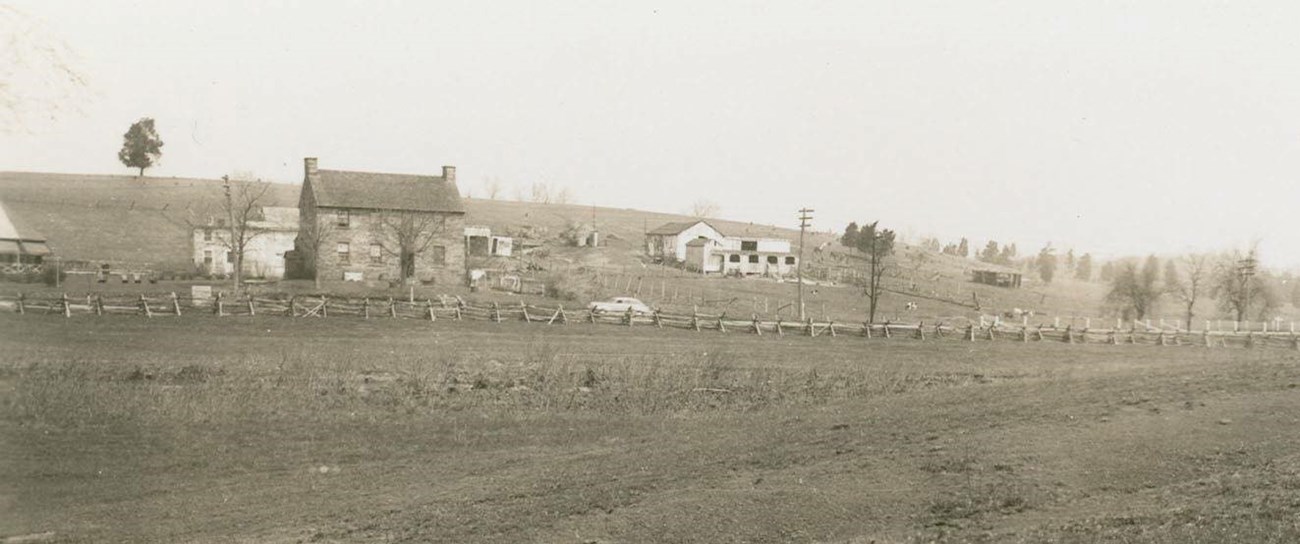
LOC
The Stone House is one of three wartime structures present within Manassas National Battlefield Park. It is situated to the north east of the intersection of modern-day Route 29 and Sudley Road. Both roads exist almost entirely atop the wartime road beds of the Warrenton (formerly Fauquier and Alexandria) Turnpike and the Sudley Road. Due to this geographic location at an important crossroads, the Stone House found itself in the heart of both battles.
Early HistoryTax records and historical accounts do not specify exactly when the Stone House was built but rather provide pieces of information about structures built on or near the lot. Earliest tax records show possible construction in 1828 by John Lee, however more recent investigations suggest that it was built in 1848 by Thomas Otway Clarke.During the antebellum years, the Sudley Road and Warrenton Turnpike were major thoroughfares for commerce and travel. Historic accountsindicate that The Stone House was used as a tavern for wagoneers and travelers. By 1850 the lot and structure had been purchased by Henry P. Matthews and His Wife, Jane Matilda Clarke. The Matthews made significant improvements to the land during their pre-war ownership, including many agricultural investments as well as improvements to the structure itself. Civil WarIn July 1861, following their retreat from Matthews Hill in the early stages of the First Battle of Manassas, Confederate soldiers utilized the house for cover. During the mid-day lull, skirmishing occured in the vicinity of the House before shifting southward to Henry Hill. As the battle progressed, the house filled with wounded soldiers. Following the Federal retreat from the battlefield, pursuing Confederate soldiers captured many Federal soldiers in the house. Following the battle, an assistant surgeon was permitted to treat the wounded. The house operated as a field hospital for several days until the patients and prisoners could be brought off.During the Battle of Second Manassas, Federal commander John Pope established his headquarters on nearby Buck Hill, just north of the house. The House was again used as a place to care for wounded soldiers. On the third day of the Battle (August 30, 1862), the Stone House came under heavy fire from Confederate artillery positioned near Groveton. In addition to the damage caused by the battle, the soldiers themselves left a unique mark on the house. Two wounded soldiers of the 5th New York Infantry carved their names into the wood floor of an upstairs bedroom. The initials of Eugene P. Greer appear on the wide plank floor. Charles E. Brehm carved his last name and began to inscribe the date (Aug 30) on the baseboard adjacent to Greer’s initials. Brehm survived the war whilesuccumbed to his wounds a month later. 
NPS Post-WarThe Civil War left the Matthews in a devastated condition. The war had damaged their home and destroyed their agricultural resources and prospects. Combined with the economic downturn in the re-construction south and the decline of the turnpike, the Matthews found themselves in trying times.Not long after the War's end in 1866, the Matthews sold the house to Gideon and Mary Starbuck. They would in turn sell the house 13 years later in 1879 to relative George E. Starbuck. The house was again sold in 1881 to Benson and Ellen Pridmore. Benson lived there until his death in 1902 when the house was sold by his heirs to Henry J. and Elvira Ayers. The Stone House was occupied by the Ayers family and their children until they sold the house to the National Park Service in 1949. During the 20th century occupation by the Ayers a number of minor additions and modifications were made to the Stone House. Additional outbuildings, and commercial structures were also constructed on the lot. Upon NPS Acquisition in the 1950s the park began stabilization work. In 1961, the park undertook a full restoration, returning the house to its wartime appearance. The landscape has been likewise restored over time to its 1861-1862 condition. |
Last updated: January 22, 2022
